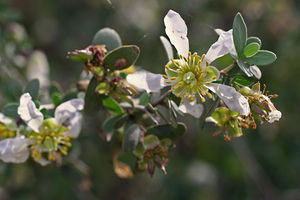Jojoba
| See Also | Food Supplements |
|---|
Jojoba is harvested for its seeds which contain a liquid wax oil which acts as a soothing ingredient in many commercial products such as shampoos, skin lotions, and make-up removers. What is unique about the oil from the jojoba seeds is that it is made up of very long straight chain fatty acids in the form of wax esters, as oppose to triglycerides. This structure makes it possible to be refined and used in cosmetics and as a carrier oil for fragrances, aromatherapy, and possibly even for drug use. The plant grows naturally in Arizona, California, Mexico and some arid African countries [1].
Food Sources
Jojoba is a bush from the Simmondsia chinensis family of plants.
Uses
The primary use for jojoba is:
- Dry Skin: A preliminary study done using jojoba and glycerol topically showed that these products work synergistically to provide moisture locking action to skin for up to 24 hours.[1]
Traditional uses for jojoba include:
- Anti-aging
- Anti-inflammatory
- Appetite suppressant
- Food additive
- Insecticidal
- Reflexology treatment
- Drug delivery
- Weight loss
- Wound healing
- Acne
Prescribing Considerations
The recommended dosages have not yet been established. To determine what your specific requirements are talk to your naturopathic doctor or other trained medical professional.
Safety
Jojoba is generally regarded as safe when used topically in oil form. Some specific safety precautions include:
- Avoid taking jojoba products orally.
- Side-effects are rare, but may include contact dermatitis.
- Children: Not recommended for children.
- Pregnancy and Breastfeeding
- Although not proven, the chance of a problem occurring during this time does exist and therefore the use of jojoba should only occur if prescribed by a medical practitioner.
References
- ↑ Meyer J, Marshall B, Gacula M Jr, Rheins L (Dec 2008) Evaluation of additive effects of hydrolyzed jojoba (Simmondsia chinensis) esters and glycerol: a preliminary study. J Cosmet Dermatol;7:(4):268-74.
